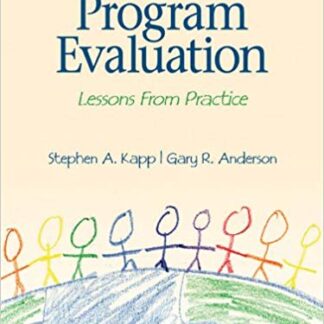Description
An Introduction to Group Work Practice 8th Edition by Ronald Toseland, ISBN-13: 978-0134058962
[PDF eBook eTextbook] – Available Instantly
- Publisher: Pearson; 8th edition (March 4, 2016)
- Language: English
- 528 pages
- ISBN-10: 0134058968
- ISBN-13: 978-0134058962
A comprehensive, coherent, organized overview of group work practice from a generalist practice perspective.
Widely used by professionals, educators, and students in undergraduate and graduate courses in schools of social work throughout the United States and the world, this text presents a comprehensive, coherent, organized overview of group work practice from a generalist practice perspective.
The new Eighth Edition continues to include typologies illustrating group work practice with task and treatment groups at the micro-, meso-, and macro-levels. Thoroughly updated throughout, the new edition of An Introduction to Group Work Practice includes:
- Research on virtual groups
- Updated and deeper content on practice with treatment and task groups
- The most current literature on working with reluctant and resistant group members
- Updated and expanded sections on working with individuals who have difficulty engaging in and sustaining work in groups
- Updated material on leadership and diversity
- Thoroughly updated reference material and new content from evidence-based practice sources
Table of Contents:
Preface
New to This Edition
About Group Work
Connecting Core Competencies Series
Instructor Supplements
1 Introduction
Learning Outcomes
Chapter Outline
Organization of the Text
The Focus of Group Work Practice
Values and Ethics in Group Work Practice
Practice Values
American Values
Group Work Values
Four Key Values
Practice Ethics
Definition of Group Work
Classifying Groups
Formed and Natural Groups
Purpose and Group Work
Treatment and Task Groups
Group Versus Individual Efforts
Advantages and Disadvantages of Treatment Groups
Advantages and Disadvantages of Task Groups
A Typology of Treatment and Task Groups
Treatment Groups
Support Groups
Educational Groups
Growth Groups
Therapy Groups
Socialization Groups
Self-Help Groups
Task Groups
Groups to Meet Client Needs
Teams
Treatment Conferences
Staff Development Groups
Groups to Meet Organizational Needs
Committees
Cabinets
Boards of Directors
Groups to Meet Community Needs
Social Action Groups
Coalitions
Delegate Councils
Summary
2 Historical and Theoretical Developments
Learning Outcomes
Chapter Outline
Knowledge from Group Work Practice and Practice Research: Treatment Groups
Differences Between Casework and Group Work
Intervention Targets
The Weakening of Group Work
Current Practice Trends
Treatment Groups
Social Goals Model
Remedial Model
Reciprocal Model
Divergent and Unified Practice Models
Evidence-based Group Work Practice
The Popularity of Psycho-educational, Structured, Practice Models
Knowledge from Group Work Practice: Task Groups
Knowledge from Social Science Research
Influential Theories
Systems Theory
Psychodynamic Theory
Learning Theory
Field Theory
Social Exchange Theory
Constructivist, Empowerment, and Narrative Theories
Summary
3 Understanding Group Dynamics
Learning Outcomes
Chapter Outline
The Development of Helpful Group Dynamics
Group Dynamics
Communication and Interaction Patterns
Communication as a Process
Interaction Patterns
Cues and Reinforcers.
Emotional Bonds.
Subgroups.
Size and Physical Arrangements.
Power and Status.
Principles for Practice
Group Cohesion
Reasons for Lack of Attraction to a Group
Trust and Self-Care
Principles for Practice
Social Integration and Influence
Norms
Roles
Status
Principles for Practice
Group Culture
Principles for Practice
Stages of Group Development
Summary
4 Leadership
Learning Outcomes
Chapter Outline
Leadership, Power, and Empowerment
Leadership, Empowerment, and the Planned Change Process
Theories of Group Leadership
Factors Influencing Group Leadership
Effective Leadership
An Interactional Model of Leadership
Purposes of the Group
Type of Problem
The Environment
Setting
Sponsor
Community and Social Environment
The Group as a Whole
Size
Time Limits, Open and Closed Membership, and Turnover
Group Dynamics
Stage of Development
The Group Members
Member Characteristics
Extent of Participation
Sharing Leadership
The Group Leader
Group Leadership Skills
Facilitating Group Processes
Involving Group Members
Attending Skills
Expressive Skills
Responding Skills
Focusing Skills
Making Group Processes Explicit
Clarifying Content
Cuing, Blocking, and Guiding Group Interactions
Data-Gathering and Assessment
Identifying and Describing Skills
Requesting Information, Questioning, and Probing
Summarizing and Partializing
Synthesizing
Analyzing Skills
Action Skills
Supporting Group Members
Reframing and Redefining
Linking Members’ Communications
Directing
Advice, Suggestions, and Instructions
Providing Resources
Disclosure
Modeling, Role Playing, Rehearsing, and Coaching
Confrontation Skills
Resolving Conflicts
Learning Group Leadership Skills
Leadership Style
Co-leadership
Summary
5 Leadership and Diversity
Learning Outcomes
Chapter Outline
Approaches to Multicultural Group Work
A Framework for Leading Diverse Groups
Developing Cultural Sensitivity
Assessing Cultural Influences on Group Behavior
Communication and Interaction
Cohesion
Social Integration
Group Culture
Intervening with Sensitivity to Diversity
Using Social Work Values and Skills
Using a Strengths Perspective
Exploring Common and Different Experiences among Members
Exploring Meanings and Language
Challenging Discrimination, Oppression, and Prejudice
Advocating for Members
Empowering Members
Using Culturally Sensitive Techniques and Program Activities
Principles for Practice
Summary
6 Planning the Group
Learning Outcomes
Chapter Outline
Planning Focus
Planning Model for Group Work
Establishing the Group’s Purpose
Assessing Potential Sponsorship and Membership
Assessing Potential Sponsorship
Assessing Potential Membership
Recruiting Members
Methods of Recruiting Members
Composing the Group
Homogeneity
Heterogeneity
Complementary Group Structure
Demographic and Sociocultural Factors
Size
Large Groups
Small Groups
Open and Closed Membership
Orienting Members
Explaining the Purpose of the Group
Familiarizing Members with Group Procedures
Screening Members for Appropriateness
Contracting
Contracting for Group Procedures
Contracting for Member Goals
Preparing the Environment
Preparing the Physical Setting
Making Special Arrangements
Securing Financial Support
Reviewing the Literature
Selecting Monitoring and Evaluation Tools
Preparing a Written Group Proposal
Planning Distance Groups
Special Considerations: Phone-Mediated Groups
Special Considerations: Computer-Mediated Groups
Summary
7 The Group Begins
Learning Objectives
Chapter Outline
Objectives in the Beginning Stage
Ensuring a Secure Environment
Introducing New Members
Round Robin
Variations on Round Robin
Variations in Group Beginnings
Defining the Purpose of the Group
Opening Statement
Involving Members
Confidentiality
Helping Members Feel a Part of the Group
Guiding the Development of the Group
Structure in Treatment Groups
Structure in Task Groups
Balancing Task and Socio-emotional Foci
Goal Setting in Group Work
Contracting
Facilitating Members’ Motivation
Addressing Ambivalence and Resistance
Expectations about Role Performance
Authentic Communication about Purposes and Goals
Promoting Prosocial Behaviors
Working with Involuntary Members
Anticipating Obstacles
Monitoring and Evaluating the Group: The Change Process Begins
Summary
8 Assessment
Learning Outcomes
Chapter Outline
Conducting Effective Assessments
Focus on Group Processes
External Constituencies and Sponsors
The Assessment Process
How Much Information?
Diagnostic Labels
Assessment Focus
Relationship of Assessment to the Change Process and Problem Solving
Assessing the Functioning of Group Members
Methods for Assessing Group Members
Self-Observation
Self-Monitoring.
Charting.
Logs and Diaries.
Self-Anchored Rating Scales.
Worker Observation
Naturalistic Observation.
Role Playing.
Simulations.
Program Activities.
Reports by Others
Standardized Instruments
Assessing the Functioning of the Group as a Whole
Assessing Communication and Interaction Patterns
Assessing Cohesion
Assessing Social Integration
Assessing Group Culture
Assessing the Group’s Environment
Assessing the Sponsoring Organization
Assessing the Interorganizational Environment
Assessing the Community Environment
Linking Assessment to Intervention
Summary
9 Treatment Groups: Foundation Methods
Learning Outcomes
Chapter Outline
Middle-Stage Skills
Preparing for Group Meetings
Structuring the Group’s Work
Degree of Structure
Involving and Empowering Group Members
Helping Members Achieve Goals
Awareness of Goals
Developing Treatment Plans
Overcoming Obstacles to Members’ Work
Helping Members Carry out Treatment Plans
Handling Crisis Situations
Using Empirically Based Treatment Methods in Therapy Groups
Working with Reluctant and Resistant Group Members During the Middle Phase
Monitoring and Evaluating the Group’s Progress
Summary
10 Treatment Groups: Specialized Methods
Learning Outcomes
Chapter Outline
Intervening with Group Members
Intrapersonal Interventions
Identifying and Discriminating
Recognizing Associations
Analyzing the Rationality of Thoughts and Beliefs
Changing Thoughts, Beliefs, and Feeling States
Cognitive Restructuring.
Cognitive Self-Instruction.
Thought Stopping.
Reframing.
Visualization and Cognitive Imagery Techniques.
Deep Breathing.
Progressive Muscle Relaxation.
Systematic Desensitization.
Mindfulness Meditation.
Interpersonal Interventions
Learning by Observing Models
Learning by Role Playing
Primary Role-Play Procedures
Own Role.
Role Reversal.
Autodrama, Monodrama, and Chairing.
Sculpting and Choreography.
Supplementary Role-Play Procedures
On-The-Spot Interview.
Soliloquy.
Doubling.
Mirror.
Sharing.
Environmental Interventions
Connecting Members to Concrete Resources
Expanding Members’ Social Networks
Contingency Management Procedures
Modifying Physical Environments
Intervening in the Group as a Whole
Changing Communication and Interaction Patterns
Changing the Group’s Attraction for Its Members
Using Social Integration Dynamics Effectively
Changing Group Culture
Changing the Group Environment
Increasing Agency Support for Group Work Services
Links with Interagency Networks
Increasing Community Awareness
Summary
11 Task Groups: Foundation Methods
Learning Outcomes
Chapter Outline
The Ubiquitous Task Group
Leading Task Groups
Leading Meetings
Sharing Information
Enhancing Involvement and Commitment
Developing Information
Dealing with Conflict
Making Effective Decisions
Understanding Task Groups’ Political Ramifications
Monitoring and Evaluating
Problem Solving
A Model for Effective Problem Solving
Identifying a Problem
Clarifying Boundaries
Members’ Perceptions and Experiences
Problem-Solving Orientation
Defining a Solvable Problem
Specifying the Problem
Developing Goals
Collecting Data
Developing Plans
Selecting the Best Plan
Implementing the Plan
Summary
12 Task Groups: Specialized Methods
Learning Outcomes
Chapter Outline
Small Organizational Groups
Brainstorming
Procedures
Uses
Effectiveness
Variations on Brainstorming
Reverse Brainstorming
Trigger Groups and Brainwriting
Focus Groups
Procedures
Uses
Effectiveness
Nominal Group Technique
Procedures
Uses
Effectiveness
Multi-attribute Utility Analysis
Procedures
Uses
Effectiveness
Quality Improvement Groups
Procedures
Uses
Effectiveness
Large Organizational Groups
Parliamentary Procedure
Procedures
Uses
Effectiveness
Phillips’ 66
Procedures
Uses
Effectiveness
Methods for Working with Community Groups
Mobilization Strategies
Capacity-Building Strategies
Social Action Strategies
Summary
13 Ending the Group’s Work
Learning Outcomes
Chapter Outline
Factors That Influence Group Endings
The Process of Ending
Planned and Unplanned Termination
Member Termination
Worker Termination
Ending Group Meetings
Ending the Group as a Whole
Learning from Members
Maintaining and Generalizing Change Efforts
Relevant Situations
Helping Members Develop Confidence
Using a Variety of Situations and Settings
Using Naturally Occurring Consequences
Follow-Up Sessions
Preventing Setbacks in Unsympathetic Environments
Helping Members Solve Problems Independently
Reducing Group Attraction
Feelings about Ending
Planning for the Future
Making Referrals
Summary
14 Evaluation
Learning Outcomes
Chapter Outline
Why Evaluate? the Group Worker’s View
Reasons for Conducting Evaluations
Organizational Encouragement and Support
Time Considerations
Selecting a Data Collection Method
Evaluation Methods
Evaluations for Planning a Group
Obtaining Program Information
Needs Assessment
Evaluations for Monitoring a Group
Monitoring Methods
Monitoring by the Group Worker
Monitoring by Group Members
Evaluations for Developing a Group
Single-System Methods
Case Study Methods
Participatory Action Research Methods (PARS)
Evaluations for Determining Effectiveness and Efficiency
Evaluation Measures
Choosing Measures
Types of Measures
Self-Report Measures
Observational Measures
Products of Group Interaction
Summary
Appendix A Standards for Social Work Practice with Groups1 Association for the Advancement of Social Work with Groups, Inc., an International Professional Organization (AASWG)
Purpose
Introduction
Overview of the Standards
Section I Core Values and Knowledge
Section II Pre-Group Phase: Planning, Recruitment, and New Group Formation
Section III Group Work in the Beginning Phase
Section IV Group Work in the Middle Phase
Section V Group Work in the Ending Phase
Section VI Ethical Considerations
Appendix B Group Announcements
Support Group for New Parents
Sponsor
Group Leaders
Membership
Dates and Times
Child Care
Cost
Youth Center Interest Meeting
Sponsor
Meeting Place
Date and Time
Further Information
Appendix C Outline for a Group Proposal Treatment/Task
Appendix D An Example of a Treatment Group Proposal
Adolescent Discharge Group
The Children’s Refuge Home
Abstract
Purpose
Agency Sponsorship
Membership
Recruitment
Composition
Orientation
Environment
Appendix E An Example of a Task Group Proposal
Task Force on Research Utilization in Probation
References
Author Index
What makes us different?
• Instant Download
• Always Competitive Pricing
• 100% Privacy
• FREE Sample Available
• 24-7 LIVE Customer Support




